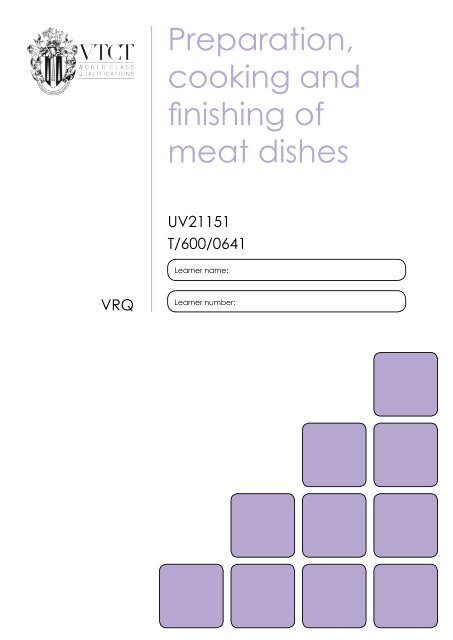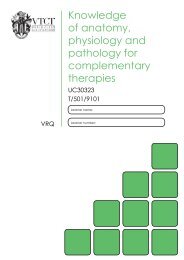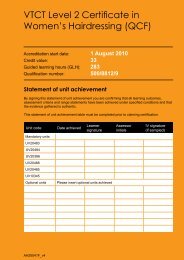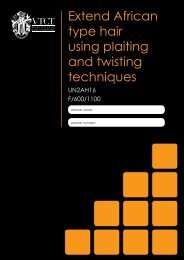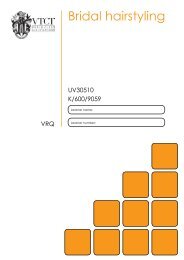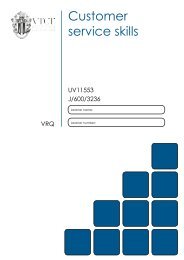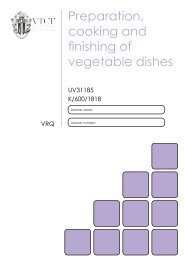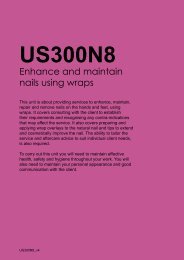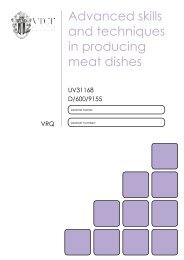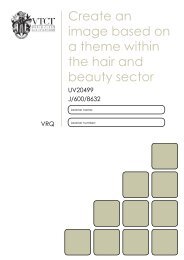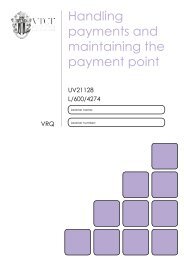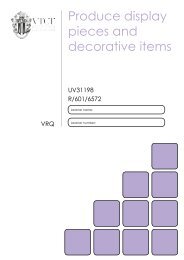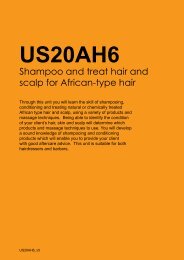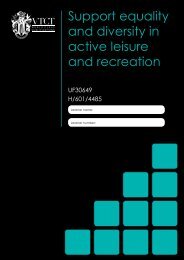Preparation, cooking and finishing of meat dishes - VTCT
Preparation, cooking and finishing of meat dishes - VTCT
Preparation, cooking and finishing of meat dishes - VTCT
Create successful ePaper yourself
Turn your PDF publications into a flip-book with our unique Google optimized e-Paper software.
VRQ<br />
<strong>Preparation</strong>,<br />
<strong>cooking</strong> <strong>and</strong><br />
<strong>finishing</strong> <strong>of</strong><br />
<strong>meat</strong> <strong>dishes</strong><br />
UV21151<br />
T/600/0641<br />
Learner name:<br />
Learner number:
Statement <strong>of</strong> unit achievement<br />
By signing this statement <strong>of</strong> unit achievement you are confirming that all learning outcomes, assessment<br />
criteria <strong>and</strong> range statements have been achieved under specified conditions <strong>and</strong> that the evidence<br />
gathered is authentic.<br />
This statement <strong>of</strong> unit achievement table must be completed prior to claiming certification.<br />
Unit code Date achieved Learner signature<br />
Assessor tracking table<br />
<strong>VTCT</strong> is the specialist awarding body for the Hairdressing, Beauty Therapy, Complementary Therapy,<br />
Hospitality <strong>and</strong> Catering <strong>and</strong> Sport <strong>and</strong> Active Leisure sectors, with over 45 years <strong>of</strong> experience.<br />
<strong>VTCT</strong> is an awarding body regulated by national organisations including Ofqual, SQA, DfES <strong>and</strong> CCEA.<br />
<strong>VTCT</strong> is a registered charity investing in education <strong>and</strong> skills but also giving to good causes in the area<br />
<strong>of</strong> facial disfigurement.<br />
Assessor name Assessor signature<br />
Assessor<br />
initials<br />
Assessors<br />
initials<br />
IV signature<br />
(if sampled)<br />
All assessors using this Record <strong>of</strong> Assessment book must complete this table. This is required for<br />
verification purposes.<br />
Assessor number<br />
(optional)
UV21151<br />
<strong>Preparation</strong>, <strong>cooking</strong> <strong>and</strong><br />
<strong>finishing</strong> <strong>of</strong> <strong>meat</strong> <strong>dishes</strong><br />
The aim <strong>of</strong> this unit is to develop your knowledge <strong>and</strong><br />
underst<strong>and</strong>ing <strong>of</strong> the preparation <strong>and</strong> <strong>cooking</strong> <strong>of</strong> <strong>meat</strong><br />
<strong>dishes</strong>. You will learn the characteristics <strong>of</strong> different types<br />
<strong>of</strong> <strong>meat</strong>, correct preparation methods, <strong>and</strong> the correct<br />
equipment required for preparing <strong>and</strong> <strong>cooking</strong> <strong>meat</strong> <strong>dishes</strong>.<br />
You will learn how to cook <strong>meat</strong> safely using appropriate<br />
methods for the different types <strong>and</strong> cuts <strong>of</strong> <strong>meat</strong>, <strong>and</strong> how<br />
to finish <strong>dishes</strong> to meet industry st<strong>and</strong>ards, organisational<br />
requirements <strong>and</strong> customer satisfaction.<br />
UV21151_v6
Level<br />
Credit value<br />
GLH<br />
2<br />
3<br />
26<br />
Observation(s)<br />
0<br />
External paper(s)<br />
0
<strong>Preparation</strong>, <strong>cooking</strong> <strong>and</strong><br />
<strong>finishing</strong> <strong>of</strong> <strong>meat</strong> <strong>dishes</strong><br />
Learning outcomes Evidence requirements<br />
On completion <strong>of</strong> this unit you will:<br />
1. Know how to prepare <strong>meat</strong> for basic <strong>dishes</strong><br />
2. Know how to cook <strong>meat</strong> for basic <strong>dishes</strong><br />
3. Know how to finish <strong>meat</strong> for basic <strong>dishes</strong><br />
1. Knowledge outcomes<br />
There must be evidence that you possess<br />
all the knowledge <strong>and</strong> underst<strong>and</strong>ing<br />
listed in the Knowledge section <strong>of</strong> this<br />
unit. In most cases this can be done<br />
by pr<strong>of</strong>essional discussion <strong>and</strong>/or oral<br />
questioning. Other methods, such as<br />
projects, assignments <strong>and</strong>/or reflective<br />
accounts may also be used.<br />
2. Tutor/Assessor guidance<br />
You will be guided by your tutor/assessor<br />
on how to achieve learning outcomes in this<br />
unit. All outcomes must be achieved.<br />
3. External paper<br />
There is no external paper requirement for<br />
this unit.<br />
UV21151<br />
3
4<br />
Developing knowledge<br />
Achieving knowledge outcomes<br />
You will be guided by your tutor <strong>and</strong> assessor<br />
on the evidence that needs to be produced.<br />
Your knowledge <strong>and</strong> underst<strong>and</strong>ing will be<br />
assessed using the assessment methods listed<br />
below*:<br />
• Projects<br />
• Observed work<br />
• Witness statements<br />
• Audio-visual media<br />
• Evidence <strong>of</strong> prior learning or attainment<br />
• Written questions<br />
• Oral questions<br />
• Assignments<br />
• Case studies<br />
• Pr<strong>of</strong>essional discussion<br />
Where applicable your assessor will integrate<br />
knowledge outcomes into practical observations<br />
through pr<strong>of</strong>essional discussion <strong>and</strong>/or oral<br />
questioning.<br />
When a criterion has been orally questioned<br />
<strong>and</strong> achieved, your assessor will record this<br />
evidence in written form or by other appropriate<br />
means. There is no need for you to produce<br />
additional evidence as this criterion has already<br />
been achieved.<br />
Some knowledge <strong>and</strong> underst<strong>and</strong>ing outcomes<br />
may require you to show that you know <strong>and</strong><br />
underst<strong>and</strong> how to do something. If you have<br />
practical evidence from your own work that<br />
meets knowledge criteria, then there is no<br />
requirement for you to be questioned again on<br />
the same topic.<br />
*This is not an exhaustive list.<br />
UV21151
Knowledge<br />
Learning outcome 1<br />
Know how to prepare <strong>meat</strong> for basic <strong>dishes</strong><br />
You can: Portfolio reference<br />
a. Describe preparation methods for <strong>meat</strong><br />
b. State the reasons for using different methods <strong>of</strong> <strong>meat</strong> preparation<br />
c. Describe the characteristics <strong>of</strong> different types <strong>of</strong> <strong>meat</strong><br />
d. Identify cuts <strong>of</strong> <strong>meat</strong><br />
e. State what should be done if there are problems with the quality <strong>of</strong><br />
<strong>meat</strong><br />
f. Identify how to store prepared <strong>meat</strong> which is ready for <strong>cooking</strong><br />
UV21151 5
6<br />
Learning outcome 2<br />
Know how to cook <strong>meat</strong> for basic <strong>dishes</strong><br />
You can: Portfolio reference<br />
a. Identify the correct tools <strong>and</strong> equipment for different <strong>meat</strong> <strong>cooking</strong><br />
methods<br />
b. Describe correct <strong>cooking</strong> methods for different types <strong>of</strong> <strong>meat</strong><br />
c. State the benefits <strong>of</strong> sealing <strong>meat</strong><br />
d. State the correct temperatures for <strong>cooking</strong> <strong>meat</strong><br />
e. State healthy eating considerations when <strong>cooking</strong> <strong>meat</strong><br />
UV21151
Learning outcome 3<br />
Know how to finish <strong>meat</strong> for basic <strong>dishes</strong><br />
You can: Portfolio reference<br />
a. Describe the correct <strong>finishing</strong> methods for <strong>meat</strong> <strong>dishes</strong><br />
b. State the importance <strong>of</strong> correctly <strong>finishing</strong> <strong>dishes</strong> for service<br />
c. State how to check <strong>meat</strong> <strong>dishes</strong> have met <strong>finishing</strong> requirements<br />
d. State the correct temperature for holding <strong>and</strong> serving <strong>meat</strong> <strong>dishes</strong><br />
UV21151 7
8<br />
Unit content<br />
This section provides guidance on the recommended knowledge <strong>and</strong> skills required to enable you<br />
to achieve each <strong>of</strong> the learning outcomes in this unit. Your tutor/assessor will ensure you have the<br />
opportunity to cover all <strong>of</strong> the unit content.<br />
Outcome 1: Know how to prepare <strong>meat</strong> for basic <strong>dishes</strong><br />
<strong>Preparation</strong> methods for <strong>meat</strong>: Boning,<br />
trimming, slicing, dicing, mincing, stuffing,<br />
tying, weighing <strong>and</strong> portioning.<br />
Reasons for using different methods:<br />
Types <strong>of</strong> <strong>meat</strong>, required end product,<br />
removing large bones, removing smaller<br />
bones.<br />
Different types <strong>of</strong> <strong>meat</strong>: Lamb, beef, veal,<br />
pork, bacon.<br />
Identify cuts <strong>of</strong> <strong>meat</strong>:<br />
Lamb – leg, loin, fillet, saddle, noisettes,<br />
best end, shoulder, shank, cutlets, chops.<br />
Beef – shin, oxtail, rump, sirloin, fillet, rib<br />
eye, brisket, topside, silverside, steaks.<br />
Veal – loin, escalope, cushion cutlets.<br />
Pork – loin, fillet, medallions, escalope,<br />
chops, belly, rib, shoulder, leg.<br />
Bacon – rashers, back, streaky, ham hock,<br />
gammon joint, gammon steak.<br />
Problems with the quality <strong>of</strong> <strong>meat</strong>:<br />
Reporting to supervisor, returning to<br />
supplier, discarding <strong>meat</strong> past sell-by date,<br />
substitute problem ingredients.<br />
Storage <strong>of</strong> prepared <strong>meat</strong>: Precise<br />
labelling, dating, refrigerated below 5°C,<br />
below any cooked foods, avoid any blood<br />
spillage, apply HACCP policies (hazard<br />
analysis <strong>and</strong> critical control points), current<br />
food safety legislation.<br />
UV21151
Outcome 2: Know how to cook <strong>meat</strong> for basic <strong>dishes</strong><br />
Tools <strong>and</strong> equipment: Salam<strong>and</strong>er,<br />
under-fired grills, ovens, frying pans, sauté<br />
pans, roasting trays, tongs, roasting fork,<br />
spoon, ladle.<br />
Cooking methods:<br />
Dry methods – roasting (beef joints, lamb<br />
best ends, pork loins), grilling (pork chops,<br />
lamb cutlets, steaks), shallow frying (stir<br />
fry beef or pork, veal or pork escalopes),<br />
baking (steak pies).<br />
Wet methods – boiling (silverside <strong>of</strong><br />
beef, ham <strong>and</strong> gammon joints), steaming<br />
(lamb puddings, steak puddings), stewing<br />
(ragout <strong>of</strong> beef, navarin <strong>of</strong> lamb, Irish<br />
stew, fricassee, blanquette), braising<br />
(carbonnade, braised steak, Lancashire<br />
Hotpot).<br />
Outcome 3: Know how to finish <strong>meat</strong> for basic <strong>dishes</strong><br />
Finishing methods: Resting, carving,<br />
portioning, serving, plating, garnishing,<br />
saucing, dish specification, appropriate<br />
accompaniments.<br />
Importance <strong>of</strong> correctly <strong>finishing</strong> <strong>dishes</strong>:<br />
Consistent st<strong>and</strong>ards, achieving quality<br />
end product, menu specification, customer<br />
satisfaction, customer requirements.<br />
Checking <strong>meat</strong> <strong>dishes</strong> have met<br />
<strong>finishing</strong> requirements: Colour, flavour,<br />
seasoning, aroma, degree <strong>of</strong> <strong>cooking</strong>,<br />
consistency, dish specification.<br />
Correct temperature: Core temperature<br />
for cooked food 75°C, hot holding<br />
<strong>and</strong> serving 63°C, current food safety<br />
legislation, HACCP.<br />
Benefits <strong>of</strong> sealing <strong>meat</strong>: Enhances<br />
colour, enhances flavour, seals in moisture,<br />
retains juices.<br />
Correct temperatures for <strong>cooking</strong> <strong>meat</strong>:<br />
Core temperature for cooked food 75°C,<br />
hot holding <strong>and</strong> serving 63°C or above,<br />
degrees <strong>of</strong> <strong>cooking</strong> (rare, medium, well<br />
done).<br />
Healthy eating considerations when<br />
<strong>cooking</strong> <strong>meat</strong>: Remove excess fats, use<br />
leaner cuts, avoid saturated fats, less salt<br />
in <strong>cooking</strong>, methods <strong>of</strong> cookery (grilling,<br />
steaming, boiling).<br />
UV21151 9
10<br />
UV21151<br />
Notes<br />
Use this area for notes <strong>and</strong> diagrams


